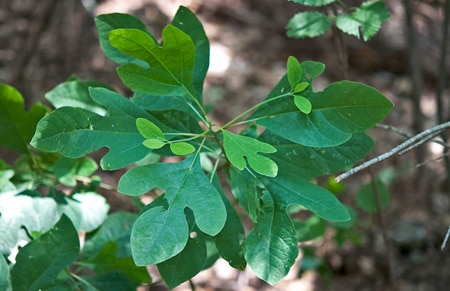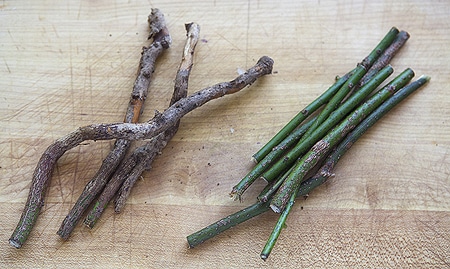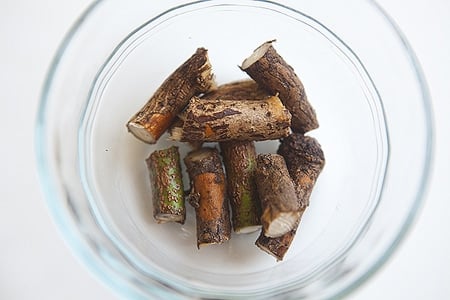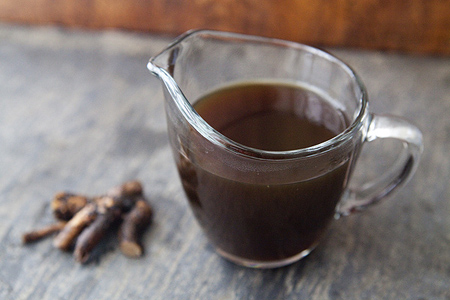As an Amazon Associate I earn from qualifying purchases.

Sassafras. The aromatic bark, leaves and roots of this little tree were believed to be the first plant exported from North America to Europe, back in the late 1500s. All parts of this little tree make for delicious — and different — teas, sweets and other confections, and sassafras commanded exorbitant prices in Europe… until everyone started drinking sassafras tea to cure their syphilis. Soon no one wanted to be seen sipping their syphilis cure in public, and the sassafras trade withered.
More recently, sassafras has been getting a bad rap by the folks at the USDA, who say that the active component of sassafras, safrole, is a “known carcinogen.” Why? They gave tons of pure safrole to rats and the rats got cancer. Later researchers noted that, like the whole saccharine scare in the late 1970s, safrole seems to cause cancer in rats — but not people.
Still, many people still think that sipping sassafras tea or eating sassafras ice cream will doom you to a date with your oncologist. Just know that there are many times more “known carcinogens” in a bottle of beer than there are in any homemade sassafras product you might make. By one calculation, you’d need to drink 24 gallons of sassafras root beer a day for an extended time to get the amount of safrole fed to those rats. And if you drank that much soda, you’d have lots of other problems to deal with…
I collect sassafras on Cape Ann, where my family lives. It’s easy to spot the telltale mitten leaves of the tree. Sassafras is unmistakable: It is a spindly, shrubby tree that lives beneath larger trees. Its upper bark is green, and the leaves come in three varieties, often on the same branch — a mitten, a three-lobed leaf, and a simple spear-shaped leaf.

The way you collect sassafras is to pull seedlings right out of the ground. I know, it sounds destructive, but it isn’t. Sassafras grows in clumps, and the parent tree sends out suckers under the ground, which then become seedlings; it’s a lot like mulberry. You find a clump — look for at least 8 to 10 treelings scattered about — go to one about 2 or 3 feet tall, grasp the very base of the tree and yank it straight up. You should come away with the seedling and about 10 inches’ worth of the root.
You did not get all of the root, you know, and this is a good thing. It will regrow later. So what seems a little wanton is actually good for the sassafras cluster — it lets the surrounding seedlings grow with less competition.
All parts of this tree are useful. Notice I did not say “edible,” because the leaves are the only part you actually eat. You know them as filé powder, and without sassafras leaves gumbo just isn’t gumbo.

Roots on the left, twigs on the right. What’s the difference? They make very different teas. The twigs have a lemony-floral flavor and aroma that one author has compared to Froot Loop cereal — not exactly a selling point in my book, but they are lovely. The roots, however, are the “root” in root beer.
I am not a tea drinker. Coffee is my breakfast drink of choice. So I was not about to switch for sassafras. But I do like using flavored syrups from wild ingredients; I recently made a delicious fir tip syrup from the young tips of a Douglas fir tree. I then use these syrups to glaze meats, make homemade sodas, sorbets or ice creams. Sassafras is a prime candidate for this treatment.
To make the twig syrup, you peel back the green bark a bit to expose it — the bark is what has most of the flavor — then simmered the twigs in hot water. The brew quickly turns a pretty amber, a little like cola. Let it steep overnight and then strain it through cheesecloth and mix it 1:1 with sugar to make a simple syrup. It is outstanding. I mean, really outstanding. Think root beer with a lot of lemon in it.
To make an authentic root beer syrup, the first thing you need to do it chop the sassafras roots.

But root beer is not just sassafras, it is a concoction of many things. My recipe is heavy on the sassafras roots, plus some burdock root, molasses for color, one clove, a star anise, some coriander seed and one drop of wintergreen extract. it really does taste like root beer! Maybe not the root beer you get in a can now, but then that no longer has any real sassafras in it. It is warm, and zingy, and, well, deliciously rooty.
If you live near sassafras trees — and you do if you live east of the Great Plains, south of Quebec and north of Orlando — by all means make this syrup. If you don’t live there, or don’t feel like foraging, you can buy sassafras root bark online. You’ll never go back to store-bought root beer again.

[recipe_name]Homemade Root Beer Syrup[/recipe_name]
[summary]Now I know this is not a traditional root beer. Traditional root beer is brewed with yeast, is mildly alcoholic — and can be tricky to make. This recipe will give you a root beer flavored syrup that tastes amazing, is stable in the fridge for a year, and needs only seltzer water or club soda to become a wonderful homemade root beer.
You will need some unusual ingredients to make this, notably sassafras roots. If you happen to live in the United States east of the Great Plains, you are in luck: Sassafras grows everywhere in that region. If you don’t live there, or don’t feel like foraging for your own sassafras, you can buy sassafras root bark online.
The burdock in the recipe grows all around you as a weed. Otherwise, many good supermarkets have burdock in the produce section: They are long pale, skinny roots often sold under their Japanese name “gobo.” If you absolutely cannot get your hands on burdock, skip it. The root beer will be different, but still fine.
If you can find it, get wintergreen extract. If not, use peppermint extract.
When you make your root beer, start with a tablespoon of this syrup to a pint of seltzer water. You can adjust the strength of your drink from there.[/summary]
[yield]Makes 2 quarts. [/yield]
Prep Time:[preptime time=5M] 5 minutes[/preptime]
Cook Time:[cooktime time=25M] 25 minutes[/cooktime]
- [ingredient][amount]6 cups[/amount] of [item]water[/item] [/ingredient]
- [ingredient][amount]3 ounces[/amount] of [item]sassafras roots[/item][/ingredient]
- [ingredient][amount]1 ounce[/amount] of [item]burdock root[/item][/ingredient]
- [ingredient][amount]1/4 cup[/amount] [item]molasses[/item][/ingredient]
- [ingredient][amount]1[/amount] [item]clove[/item][/ingredient]
- [ingredient][amount]1[/amount] [item]star anise[/item][/ingredient]
- [ingredient][amount]1 teaspoon[/amount] [item]coriander seeds[/item][/ingredient]
- [ingredient][amount]2 drops[/amount] [item]wintergreen extract[/item] or [item]peppermint extract[/item][/ingredient]
- [ingredient][amount]6 cups[/amount] [item]sugar[/item][/ingredient]
____________
[instructions]
- Chop the sassafras and burdock roots into small pieces, about 1/2 inch or smaller.
- Put the roots in a medium-sized heavy pot with the clove, star anise and coriander seeds and cover with the water. Cover the pot and bring it to a boil. Simmer this for 15 minutes.
- Add the molasses and simmer another 5 minutes.
- Turn off the heat and add the wintergreen or peppermint extract. Put the cover back on the tea.
- When the mixture cools, strain it though cheesecloth to remove any debris.
- Return it to the pot with an equal amount of sugar. Stir to combine. Bring it to a simmer and cook it for 5 minutes, uncovered. Pour into quart mason jars and seal. Keeps a year in the fridge.
[/instructions]




Hi Hank,
You mentioned that the ratio of sugar to water had to be the same. I added six cups of water, but after it boiled and simmered, only 3 were left, so I added three cups of sugar. Is the end result supposed to be thick like molasses or more watery? Mine is watery. Should I add more sugar?
Paula
When I was young and wanting to make sassafras tea for school I asked my neighbor for some help as I knew he was clearing some off of his land. He gave me some pieces from a root that was 6 inches in diameter. I found the whole root was highly flavorful so perhaps the age/size of the root also matters. Also the leaves make a tasty garnish for some sandwiches.
I just made the root beer syrup for a living history program we’ll be doing in a few weeks at a gold mining camp. I was wondering what the ratio of syrup to sparkling water would be. A teaspoon or a tablespoon? I think the kids are really going to enjoy it. Thanks for sharing it.
Just brewed a batch. My syrup is cooling and I am on my way to the corner store for seltzer! The syrup tastes divine.
Thanks Hank.
f.y.i. wintergreen oil is otherwise known as methyl salicylate. it’s an external analgesic, among other things. i mix up a killer “witch’s brew” for all kinds of aches and pains, even open wounds. i use it and camphor, menthol, DMSO, eucalyptus oil, aloe, lavender oil, & many other lesser essential oils. i have fibromyalgia, degenerating disc ‘s, costal chondritis, to name just a few maladys. and oh my does this stuff work wonders. my friends all love it too. anyhow, i order large amounts of the first several ingredients when making up a batch and all i did was type in (on the www) wintergreen oil or methyl salicylate and you’ll get many responses. i just looked for the cheapest, in this last case i bot 16 oz. for $26.95 incl shipping.
thanks for your great information and responses from people who actually sound like they have a brain in their heads. most of these dialog sites i’ve happened across are pretty useless. i originally was looking for sassafras bark for tea making purposes, but you all have got me jazzed about making root beer now. can’t wait to try it! thanks again, the purple lady.
p.s. i live in s.w. washington state so i won’t be foraging. too bad.
Just returned from a trip to the farm in North Carolina for a Christmas visit with the family. Remembered sassafras from childhood when my Mom made tea for cleasing the blood and we drank it often. My nephew gathered the roots for us (I shared it with my step-daughter who is a naturalist). We both brought home sassafras roots for the tea. The root beer is an interesting alternative and we plan to try it. Thank you for the alternative uses for the plant. I will share the the recipes with my nephew. I’m sure that he will use it to make the file, as he makes gumbo and will love making the root beer. Thank you for sharing.
Hey Hank, Got the root beer syrup done — it’s fantastic! I posted it today (https://www.storyofakitchen.com/drink-recipes/homemade-root-beer-syrup/). I foraged around, looking for some sassafras in my neighborhood without any luck. I ordered my sassafras root bark online at Mountain Rose Herbs. Thanks for the recipe!
Hank And Elise You 2 R Great, I’ve tried your rub for RIBS, will never eat out again, I will make them at home, And the Sassafras Root Beer Is out of this world GOOD, I live in Rhode Island. And do a lot of Foraging for Mushrooms, So as soon as I saw your Sassafras Recipe, I broke out the Camera and was out the door, Within 5 minutes I found plenty of Sassafras seedlings around one of my favorite fishing Holes, Now that I taught my grandson how to Forage and make it, We’ll have those Memories embeded for Life, while sitting back drinking this Delicious Treat. Thank You Both for sharing such Knowledge. Sincerely Kevin
Hello Hank,
Do you visit Cape Ann often? I live in Gloucester and would love to forage and break bread with you next time your in the area. In the meantime I will be walking across my street and gathering some sassafras, I can’t wait. I have to say thank you for the knowledge I like how you share multiple uses for one ingredient. thanks again.
Best regards,
Christian Collins
I grew up in Maryland with sassafras all around me. I have lived in Missouri for the last 20 years and recently found a sassafras tree on our 100 acres. My kids cannot wait to try homemade root beer. We live off the land as much as possible and this will be educational for my kids….just like milking the cow, cheesemaking and baking sourdough bread. Thanks for the information you have provided.
Hank great site, I teach wild edibles for many years now just want to let all our fellow wild free food followers that sassafras tea and all other recipes have been around for hundreds of years. even longer . modern man has no idea how to live after nature. I was once told by someone that if i taught all the people how to hunt for wild foods there would be nothing left in the wild lmasf . please keep up the great work people need to know theres more out there than the grocery stores
Story: There is a difference. The bark has most of the flavor. So I imagine buying just the bark will give you more flavor for less weight.
Hank, I’ve been looking for sassafras root or sassafras root bark, but am having trouble with discerning if there is a difference between “sassafras root” and “sassafras root bark.” Does the recipe call for the roots (like your fourth photo shows)? Or the bark of the root? The reason why I’m nit-picking over the details is that I’ve found a site online that sells sassafras root bark (amazon) as well as another (mountain rose herbs), much more inexpensively, that sells sassafras bark. Is there a difference? I am excited to try your recipe!
I made this today. I found the Sassafras root and the Burdock root at the Sacramento Natural Foods Co-op, in the bulk section.
Thanks for the recipe!
Thanks, I’ll give it a shot and post the results!
Greenjeans7: Sorry, I have no idea – it all depends on how strong you like your root beer. I put about a tablespoon of syrup into my root beer, if that helps.
Thanks for the reply. I guess I misunderstood the recipe. I now see that it said 2 qts. My question now, is this 2 qts of concentrated syrup and if so how many gallons approx. will it make?
Greenjeens7: It makes about 2 quarts.
How much finished product does this base make? We usually make 5 gal. of finished product and keg it.
My sister-in-law found another recipe and told me about it after she made a batch. I want to try this. Was wondering if it could be canned, or must it be stored in a cold place? I also learned about file’ during my research. I always thought there should be a use for the leaves. I remember chewing the leaves as a kid. I’ m originally from Ohio were sassafras grows good. It also grows where I live now. I have some on my property so I don’t have to look for it. Looking forward to try this. Glad it has a long shelf life uncanned.